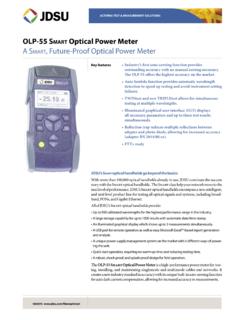Transcription of TriControls
1 Abbott Point of Care Inc. Abbott Park, IL 60064 USA Art: 723270-00A Rev. Date: 20-Apr-12 TECHNICAL BULLETINi-STAT TriControlsControl Materials for Liquid QC and Calibration VerificationOVERVIEWAs part of the READi initiative (Responds, Enhances, And Delivers innovations), Abbott Point of Care (APOC) has released a new set of aqueous control and calibration verification materials that combine the ability to assay hematocrit, blood gases, electrolytes, and chemistries. This enables reduced control testing in cases where all of these tests are being evaluated and : The additive used to simulate the effect of hematocrit results in reduced precision.
2 Refer to the Precision section at the end of this document for additional details. Abbott List NumberDevice Name05P71-01 TriControls Control Level 105P72-01 TriControls Control Level 205P73-01 TriControls Control Level 305P70-01 TriControls Calibration Verification Set Levels 1-5 Art: 723270-00A Rev. Date: 20-Apr-122 CONTROLS FOR BLOOD GAS/ELECTROLYTE/METABOLITE CARTRIDGES (i-STAT TriControls )Control SolutionsAqueous-based control fluids are available for verifying the integrity of newly received cartridges. i-STAT TriControls Level 1, 2 and 3 are formulated at three clinically relevant levels with defined pH and hematocrit values and with known concentrations of:SodiumPCO2 GlucosePotassiumPO2 LactateChlorideTCO2 BUN/UreaIonized CalciumCreatinineEach level of control is packaged in a box containing 10 individual mL glass ampules.
3 The control solutions do not contain human serum or serum products, but do contain buffers and Ingredients for TriControls MaterialsAnalyteCalibration Verification Level 1 Calibration Verification Level 2 and Control Level 1 Calibration Verification Level 3 and Control Level 2 Calibration Verification Level 4 and Control Level 3 Calibration Verification Level 5Na (mmol/L)97118124150159K (mmol/L) (mmol/L)677694119134 Glu (mg/dL)5952851606553 Urea (mg/dL) (mmol/L) (mmol/L) (mg/dL) (mmHg)9665402612PO2 (mmHg)4063120163500H+ (pH) storage at 2-8 C (35-46 F) should be maintained until the printed expiration date on the box and ampule labels. TriControls solutions may also be maintained at room temperature (18-30 C; 64-86 F) for up to 5 days. Do not use TriControls solutions past the labeled expiration date on the box and ampule Art: 723270-00A Rev.
4 Date: 20-Apr-12 Best ResultsFor best results, ampules, cartridges and handhelds should be at the same UseWhen using cartridges that contain sensors for pH, PCO2, PO2 and ionized calcium, a separate ampule must be used for each cartridge being not use residual TriControls solution that may be in a syringe, ampule or capillary tube for additional testing of cartridges that contain sensors for ionized calcium, pH, PCO2, or PO2. However, cartridges without these sensors may be tested with remaining fluids if that testing is performed within 10 minutes of opening the Usei-STAT TriControls solutions require different temperature stabilization times depending on whether or not PO2 is to be measured. If PO2 is to be measured, equilibrate the ampule to room temperature for 4 hours prior to use.
5 If PO2 is not being measured, equilibrate the ampule for approximately 30 minutes at room temperature. ProcedureSTEPACTION1 Access the Control option under Quality Tests in the Administration Menu. Enter the required information. The handheld allows 15 minutes (or the customized timeout) to insert the cartridge after the last data before use, shake the ampule vigorously for 5 to 10 seconds to equilibrate the liquid and gas shake, hold the ampule at the tip and bottom with forefinger and thumb to minimize increasing the temperature of the solution. If necessary, tap the tip of the ampule to send solution back into the bottom section of the fingers with gauze, tissue or glove, or use an ampule breaker to snap off the tip of the ampule at the transfer the solution from the ampule into a capillary tube or syringe, and then immediately transfer the solution into a seal the cartridge and insert it into a handheld it is important not to expose the solution to room air since this will alter the results.
6 Note: Since aqueous based solutions such as control materials lack the buffering capability of whole blood, the transfer process from ampule to cartridge must be more expedient than with a patient sample. Art: 723270-00A Rev. Date: 20-Apr-124 Transfer with Capillary TubePlain capillary tubes are recommended to transfer an aqueous control solution from the ampule to the cartridge. When using a capillary tube (fresh capillary tubes with sufficient fill capacity are recommended), fill from the bottom of the ampule to avoid drawing air into the capillary tube. Avoid drawing solution from the surface by placing a finger over the far end of the tube as it is inserted into the ampule. Once the open end of the tube rests at the bottom of the ampule, uncover the other end to allow filling by capillary with SyringePlain syringes (fresh 1cc or 3cc sterile syringe with 16 20 gauge needles) are recommended to transfer aqueous control solutions from the ampule to the cartridge.
7 When using a syringe, slowly draw approximately 1mL of solution from the bottom of the air is trapped between the leading edge of the solution and the plunger, do not invert the syringe to expel it; this will not affect solution near the tip of the air bubbles are continually drawn into the syringe, or if a bubble is trapped near the tip of the syringe, discard the ampule and syringe and use a fresh ampule and one or two drops from the syringe before filling the ValuesTarget values (determined by testing multiple ampules of each level using multiple lots of cartridges and i-STAT handhelds that have passed the Electronic Simulator test) are printed on a Value Assignment Sheet posted on the APOC website at Ensure that the lot number printed on the Value Assignment Sheet matches the lot number on the label of the ampule and that the software version above the target value table matches the software version in the ranges displayed represent the maximum deviation expected when controls and cartridges are performing results outside these ranges be obtained, refer to the Troubleshooting section that follows the Procedure for Testing Controls in the System Values are specific to the i-STAT System.
8 Results obtained when testing these aqueous controls with other methods may differ due to matrix effects. Correction of PO2 at Extreme AltitudeThe partial pressure of oxygen in a solution will change as it equilibrates to the surrounding ambient pressure. The rate of change is faster in aqueous solutions than in whole blood due to the absence of hemoglobin which binds oxygen. This is of practical significance when testing aqueous solutions on blood gas analyzers as there will be a detectable shift in the partial pressure of oxygen in the sample as it equilibrates to the pressure in the flowpath of the Art: 723270-00A Rev. Date: 20-Apr-12 The ranges for i-STAT aqueous control solutions are established for the degree of oxygen equilibration that occurs in cartridges tested at or near sea level.
9 PO2 results for aqueous solutions, including i-STAT controls and Calibration Verification Set and proficiency (external quality control) samples, can be corrected for higher altitude environments using the following equations. Observed PO2 values should be corrected before comparing them to the values on the Value Assignment Sheet posted on the APOC website at :For PO2 values below 150 mmHg:PO2 corrected = PO2 observed + ( x (760 BP))Where BP is the barometric pressure reading from the Analyzer Status screen.(Approximate change: For every decrease of 15 mmHg in pressure from 760 mmHg, add 1 mmHg to the observed value.)For PO2 values above 150 mmHg:PO2 corrected = PO2 observed + ( x (760 BP))Where BP is the barometric pressure reading from the Analyzer Status screen.
10 (Approximate change: For every decrease of 35 mmHg in pressure from 760 mmHg, add 1 mmHg to the observed value.)CALIBRATION VERIFICATION FOR BLOOD GAS/ ELECTROLYTE/ METABOLITE CARTRIDGES (i-STAT TriControls ) PurposeCalibration Verification is a procedure intended to verify the accuracy of results over the entire measurement range of a test. The performance of this procedure at defined intervals may be required by regulatory accreditation bodies. While the Calibration Verification Set contains five levels, verification of the measurement range could be accomplished using the lowest, highest and mid of ProcedureIt is recommended that each sensor type be included in the Calibration Verification procedure using a selection of handhelds that have passed the Electronic Simulator check.









